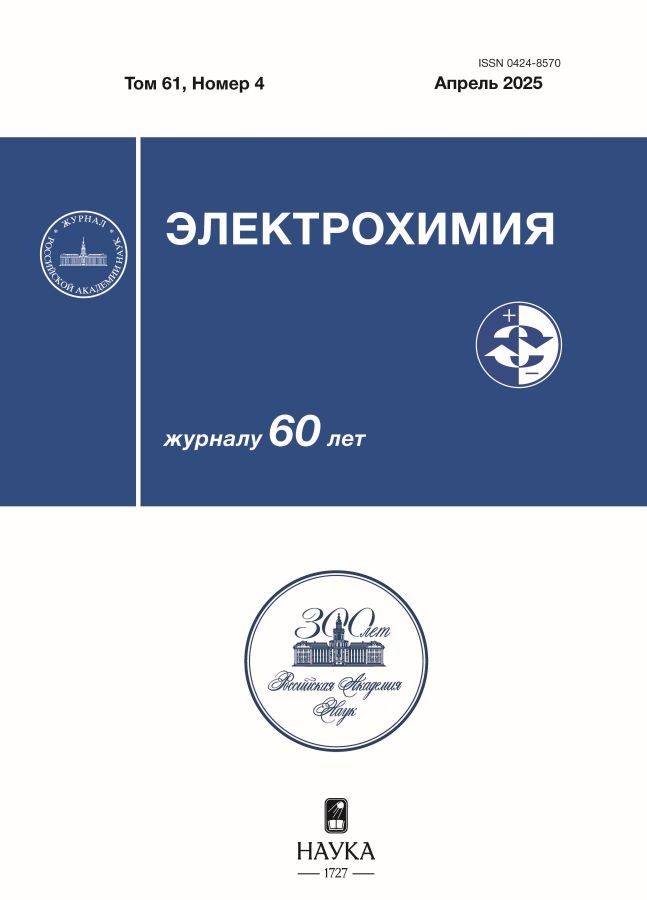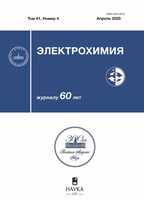Èlektrohimiâ
Russian Journal of Electrochemistry is an international journal covering all aspects of research in Pure and Applied Electrochemistry as well as in Electrochemical Materials Science.
Both original (full-size, short-communication and letter-to-editor types) and review manuscripts may be submitted in English or Russian by authors of any country(ies).
Media registration certificate: No. 0110270 dated 09.02.1993
Edição corrente
Volume 61, Nº 4 (2025)
- Ano: 2025
- Artigos: 3
- URL: https://permmedjournal.ru/0424-8570/issue/view/13512
Edição completa
Articles
Effect of acetic acid on the resistance to local corrosion of 13% chromium steel in CO₂-containing environments
Resumo
The effect of concentration of acetic acid ranged from 0 to 5000 ppm on the processes of initiation and propagation of pitting corrosion in martensitic class stainless steel containing 13% chromium was studied. The research was conducted in CO₂-saturated 5 wt. % sodium chloride solutions at various temperatures using electrochemical methods, including cyclic potentiodynamic polarization and pulse potentiostatic technique. The results show that the presence of acetic acid stimulates the formation and development of localized corrosion, increases the metal dissolution rate within the pits, promotes the initiation of a greater number of pits, and facilitates their spread on surface, leading to the expansion due to smaller pits adjacent to the main ones.
 200-209
200-209


Gas permeability of modified perfluorinated sulfonic acid membranes when operating in a proton exchange membrane fuel cell
Resumo
The gas permeability of perfluorinated proton-exchange MF-4SC membranes modified with an inert fluoropolymer and zirconium hydrogen phosphate was studied under operating conditions of a proton exchange membrane fuel cell using electrochemical methods of cyclic and staircase voltammetry. The adequacy of the methods used for estimating the hydrogen crossover current was demonstrated using membranes of different thicknesses. The relationship between the membrane permeability for hydrogen and the diffusion permeability for the electrolyte solution was studied for membranes modified with zirconium hydrogen phosphate. The optimal content of the inert fluoropolymer and zirconium hydrogen phosphate in the proton-exchange perfluorinated MF-4SC membrane was found, which ensures an increase in the power characteristics of the fuel cell and reduced hydrogen permeability.
 210-220
210-220


Specific electrical conductivity of concentrated solutions of 1-butyl-4-methylpyridinium tetrafluoroborate in dimethylformamide
Resumo
The distance between ions and molecules of ionic liquid in solution is estimated. It is found that in the concentration range of 1–2 mol/l, a maximum should be expected on the concentration dependence of specific electrical conductivity (EC), since contact ion pairs are formed in the solution. Specific EC of concentrated solutions of 1-butyl-4-methylpyridinium tetrafluoroborate in dimethylformamide was measured in the temperature range of 10–70°C, and the density of these solutions was measured in the temperature range of 10–60°C. The dependences of specific EC and density on temperature and concentration are analyzed. The density of solutions decreases linearly with increasing temperature, and specific EC passes through a maximum with increasing concentration. With an increase in temperature from 10 to 70°C, the concentration cmax corresponding to the maximum EC κmax increases from 1.258 to 1.825 mol/l. To generalize the temperature and concentration dependences of the specific EC, the normalized EC κ/κmax and normalized concentration c/cmax were used. In the coordinates κ/κmax – c/cmax, all values of the normalized EC κ/κmax fit on to a single curve. It is shown that at concentrations not exceeding ~1.0 mol/l, with increasing temperature, the specific EC κ increases in direct proportion to the limiting high-frequency electrical conductivity of the solvent κ∞. Based on the analysis of the κ – κ∞ dependencies, the solvation numbers of ionic liquid ions in dimethylformamide were determined, which decrease from 2.89 to 1.09 with an increase in concentration from ~0.1 to ~1.0 mol/l.
 221-234
221-234













